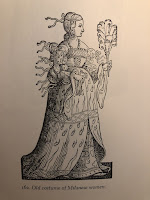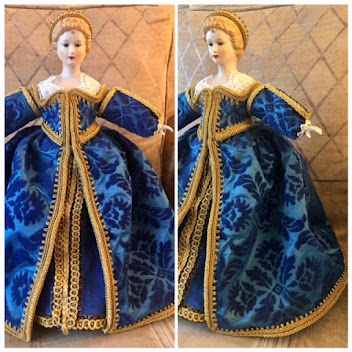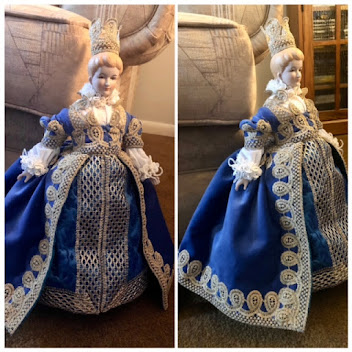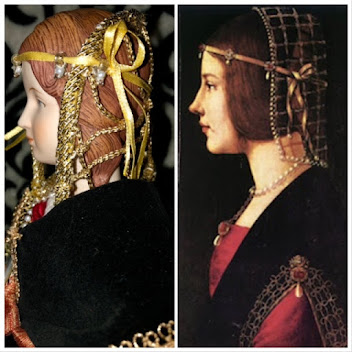The current project at hand is to dress some porcelain dolls in renaissance gowns from Italy, England, France, and Germany. Currently considering purchasing and making one more doll for Spain as well. So some good decisions and lots of sewing fun in the future. These are dolls for my own enjoyment and to keep my sewing skills in practice since I haven't made a doll since the Dastardly Doll project in 2020. Trying to find gowns that would reasonably use the ruff and cuff combination as I have made the smocks already. I am researching gowns currently from in these geographical areas, for clothing from 1560-1580 for three of the dolls. It was quite challenging to find porcelain kits that would work with the older hairstyles suitable for this period in history.
The Italian gown is already decided to be, 1490s Milan in red and black for Juliette. Inspired by the painting Portrait of a Lady by Giovanni Ambrogio de Predis. Located an image of a woodcut noted from fashions of Milan in "Vecellio’s Renaissance Costume Book" by Cesare Vecellio. When something works go with it, no sense in fighting inspiration. I will keep the red and black colors from the painting but will use this woodcut to help fill in some details for texture and decoration. Fingers crossed for some stunning details for this doll. I love all the ribbon detail in the image along with the patterns on the gown. Although the gown from the painting doesn't look as fancy. Considering an amalgamation of the two might need to happen. We shall see how this one turns out.
The English gown is going to be a 1560s gown in red velvet, as noted in a previous post for Abigail's redheaded doll. Currently looking for details that are not royal but nobler for this outfit. Since there are many images of Elizabeth I from this time frame. I am trying to work something more toned down but still courtly. Also using "Vecellio's Renaissance Costume Book" and cross-referencing it with "What People Wore When"
finding many images used from the earlier book in the later book. Although colored in and detailed in the later book. The image to the right is the original image of the woodcut. I see a fur-lined English fitted gown over a kirtle, so I am going to just use the image of this and an image of Queen Elizabeth in a plain velvet gown as inspiration for this doll, create a caul for the back of the head. Not going to use the black hat as seen in the woodcut. This doll is just going to be wearing more of an indoor courtly look. Although this shows a nice sleeve and ruffs around the wrist. I am trying to avoid making loose gowns or fitted gowns over top a fancier kirtle. As that was popular at the time that I am researching. It does look sharp but not the goal this time.
I have plans for a green gown made in the French style from about 1560. This style has a similarity in style to the gown I will be creating for Abigail in an English style. As the English did borrow styles from the countries they traded with on a regular basis. So many Netherlands and French clothing styles traveled to England. Just as in the past, sometimes a look was changed to suit the wearer. I have a better woodcut image of this gown, that will help me with both gowns. The sleeves I noticed in the prior woodcut on the fitted English gown are more embellished than on the French noblewoman. Although decoration is something I can figure out. Seeing opportunities to use some beads that I just purchased, is exciting.
As far as the gown for Germany from this time frame of the 1560s. I am familiar with 1530's Cranach Saxony style gowns but that is too early for the style of the ruffed smock with wrist ruff that I made for the dolls. So back to "Vecellio's Renaissance Costume Book" again to find something regionally appropriate. In the latter mentioned book, there were not many good images of Germany other than the earlier styles. Only 4 of a later style used the loose gowns overtop a fitted high-necked kirtle So it was better to use their sources to find an image. So found this one of a young noblewoman from Ausberg which is located in modern Germany. There were some swiss images and other areas but wanted something more generally representative, that was using ruffs as well.

Relating to Spanish styles for the possible 5th doll in this series. I have one image of a woodcut in mind from "Vecellio's Renaissance Costume book". The book is half-filled with Italy but makes sense since he would be more familiar with the regional styles from his part of the world. Since Italy was a collection of city-states at this time, styles varied from region to region. Luckily there are smaller chapters in other areas of Europe, which are very valuable. So wanted a hanging sleeve since this region is known for that style in the 1550s and later. Spain had introduced the style to other regions, like Italy and central Europe. So quite a nice high necked style but each one has subtle region differences. Should be challenging to make these court styles for 16" and 17" dolls.
Here's to good things in the future,
Marrin










No comments:
Post a Comment